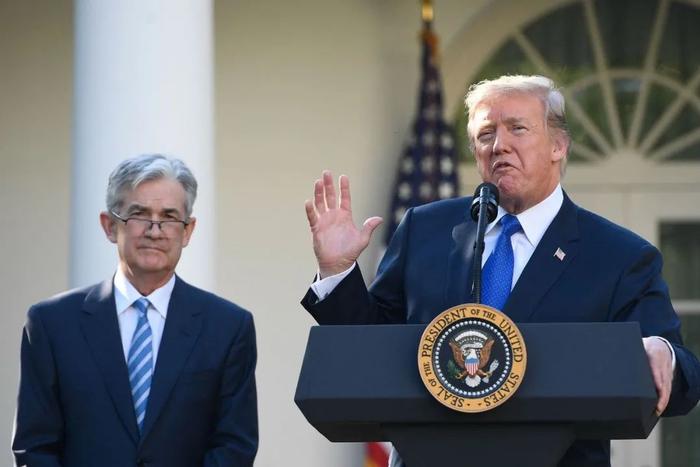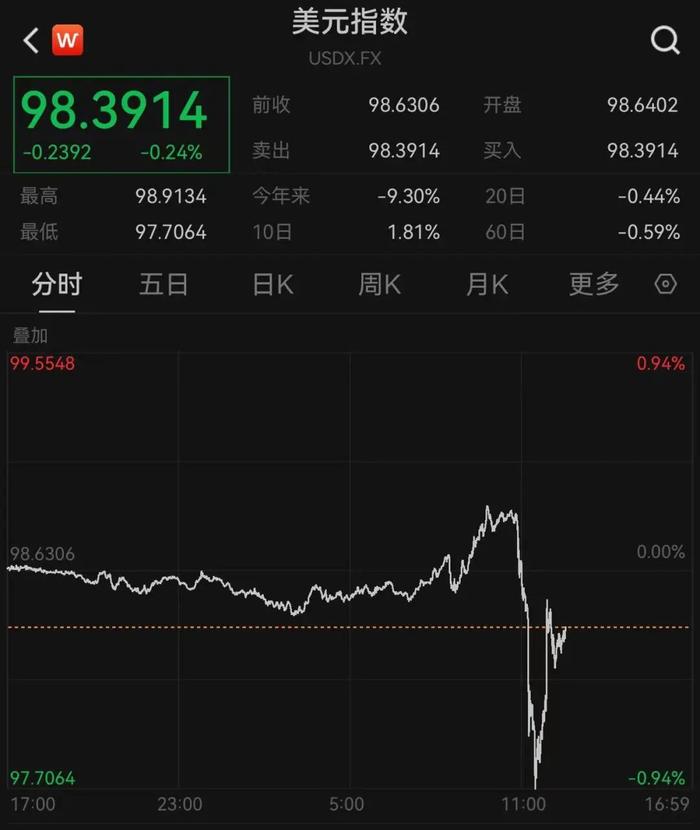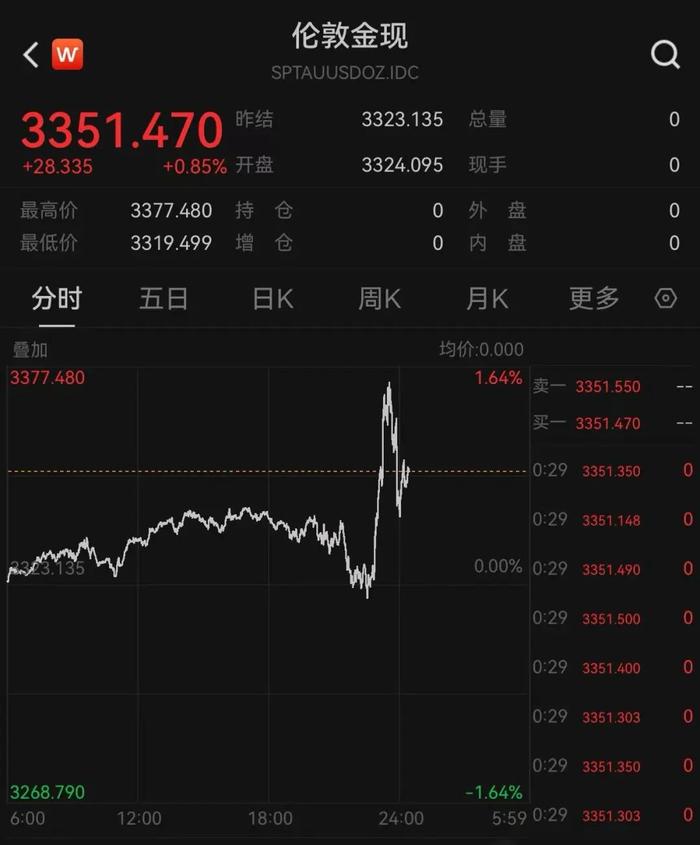



On the evening of July 16th, the global market experienced a shocking moment. Shortly before,
President Trump might soon fire Federal Reserve Chairman Jerome Powell.
According to The New York Times,
Trump has drafted a letter to fire Federal Reserve Chairman Jerome Powell.
Following the news, the three major U.S. stock indexes plummeted, gold prices surged,
reaching $3377 per ounce, at one point increasing by 1.64%,
but soon after, the market underwent a significant reversal.
CCTV International News on July 17th reported that, in midday local time on July 16th, President Trump once again emphasized during his discussion with Federal Reserve Chairman Powell, “Powell is terrible and hasn’t done his job well.” However,
regarding reports from several American media outlets earlier about “Trump might soon fire Powell,” President Trump stated that there are currently no plans to take any action, nor has he drafted a letter to fire Powell as some American media outlets reported.
However, he did discuss the topic with lawmakers and indicated that personnel adjustments would be made within eight months—Powell’s term should end in May next year.
He “probably won’t fire Powell unless fraud is proven”
. He also mentioned that White House economic advisor Kevin Hassett is someone he is considering for the Federal Reserve position. The day before, President Trump also said Treasury Secretary Steven Mnuchin was a candidate for the Federal Reserve chairman position.
Powell was appointed by President Trump during his last presidency. Since President Trump returned to the White House this year, he has frequently pressured the Federal Reserve to cut interest rates, repeatedly criticized Powell, and threatened to remove him from his role as Federal Reserve Chairman. Powell stated that President Trump lacks legal authority to dismiss him as a presidential official; he will continue working until his term ends, which is May 2026.
Recently, the Trump administration has attempted to “fire” the Federal Reserve Chairman, Jerome Powell, by exploiting the high cost of renovations at the Fed headquarters as a new “breakthrough point.”
Following this news, the three major U.S. stock indices nearly recovered their intraday losses.
The increase in international gold prices also narrowed.
The U.S. Dollar Index briefly plummeted before rallying.
The Fed’s renovation project exceeded its budget by $700 million.
Trump: Enough to Fire Powell
On July 15th, local time, President Donald Trump stated that the cost overruns in the renovation of the Fed headquarters were sufficient reasons to fire Federal Reserve Chairman Jerome Powell.
During an airport conversation on the same day, when asked if the renovation issues constituted “something that could be fired for,” Trump said, “I think so.”
Since the beginning of the year, Trump has repeatedly criticized Powell and threatened to fire his position as Fed Chair, pressuring the Fed to cut interest rates. Recently,
the Trump administration frequently mentioned the $2.5 billion renovation project at the Fed building and the “cost overruns,” escalating pressure on Powell.
The renovation project at the Fed building began during the presidency of former President Joseph Biden. According to U.S media reports, the initial budget for the project was set at $25 billion in 2019.
However, due to significant increases in costs for timber, steel, and cement,
the budget was increased to nearly $2.5 billion.
On July 2nd, the Trump administration requested Congress investigate Powell under the grounds of “political bias” and “false statements made in Congress,” accusing Powell of leading the Fed headquarters renovation project with significant violations, including luxury renovations. He also claimed that Powell deliberately concealed facts and adopted a negative attitude during congressional inquiries,
which should warrant “dismissal and accountability.”
In response to inquiries, Powell admitted that the renovation project exceeded its budget but denied the luxury renovation allegations, arguing that
the renovation was necessary to meet “safety and modernization” requirements.
On the 11th, the Federal Reserve defended its $2.5 billion renovation budget in a statement on its official website, stating that “this project involves the comprehensive renovation and modernization of two historic buildings, which have never been systematically renovated since their construction in the 1930s.”
On the 13th, U.S. White House economic advisor Larry Kudlow openly declared in a media interview that, with proper justification, President Trump has the right to fire Federal Reserve Chairman Jerome Powell. He also accused the Federal Reserve of “having a significant responsibility” for the overrun on its Washington headquarters renovation project. Kudlow stated that whether Powell would be fired due to an “overrun of $700 million” would largely depend on the response of the Federal Reserve to Russell Ware’s inquiry into the White House and Office of Management and Budget Director.
On the same day, Trump also expressed his support for Powell’s resignation if he were to step down. Trump said, “I hope he resigns, he should resign because he is very detrimental to the country.” Additionally, on the 9th, Trump had mentioned that the Federal Reserve’s interest rates were at least 3 percentage points higher than they should be.
According to Xinhua News Agency, the U.S. government announced on the 15th that the June consumer price index saw its largest year-on-year increase since February. According to American media, this indicates that President Trump’s tariff policies are putting pressure on Americans, leading to a shrinking wallet for ordinary consumers.
Data released by the U.S. Bureau of Labor Statistics showed that the June consumer price index increased by 2.7% year-on-year, surpassing market expectations and marking the largest year-on-year increase since February. Excluding fluctuations in food and energy prices, the core inflation rate in the U.S. rose by 2.9% year-on-year in June.
Economists believe that the data released that day also serves as a warning for the Trump administration’s preparation to start imposing new tariffs starting August 1st.
Some experts believe that an increase in inflation rates could signal that the Trump administration’s implementation of new tariffs will lead to a significant rise in prices.
Gregory Daco, Chief Economist at Ernst & Young-Boston Consulting Group, estimates that if the new tariffs are implemented on August 1st, the average tariff rate in the United States could rise to 21%, triggering “significant economic risks.”
White House Press Secretary Karine Jean-Pierre attempted to downplay the impact of inflation data on the 15th, emphasizing that core inflation rates still meet analysts’ expectations. President Trump himself stated that the economic data is “very good,” and “we don’t have inflation.”
On the same day, Trump once again requested the Federal Reserve to cut interest rates. The Fed, having not yielded to Trump’s pressure and remaining cautious, has been repeatedly criticized by Trump over the past few months for its chairman Jerome Powell, with threats of removal. On the 15th, U.S. Treasury Secretary Steven Mnuchin said that the White House had begun selecting potential successors to Powell. Reports indicate that Mnuchin himself is among the potential candidates.
However, according to The New York Times, given evidence of tariff policies starting to affect prices, even some of Trump’s allies admit that the Fed is unlikely to decide on a rate cut at its monetary policy meeting later this month. Conservative economist Stephen Moore, who was once a Trump advisor, believes that even if it attracts Trump’s wrath, the Fed might remain inactive this month. However, the White House needs to fully focus on the level of inflation, ensuring it does not rise to 3% or 4%. “Otherwise, people will start realizing, ‘Oh, these government policies are failing.'”
It is worth mentioning that Powell responded to Trump earlier this month,
stating that the Fed’s monetary policy must be “entirely non-political,” reiterating that the central bank is still observing the impact of U.S. tariffs before making further decisions.
Powell’s term should end in May 2026.
According to U.S. law, although the Federal Reserve Chairman is nominated by the President of the United States, the Fed does not directly report to the President and enjoys a high degree of independence. Since the interest rate cut in December last year, the Fed has maintained its benchmark interest rate unchanged. In recent months, Trump has repeatedly criticized Powell for failing to cut rates.
Analysts believe that since the establishment of the Fed, no president has ever fired the Fed Chair. If Trump breaks this tradition, it would mean undermining the independence of the Fed as the central bank of the United States. The so-called “market economy” and “independence of policies” that the United States has always prided itself on are being eroded by political plans and administrative interventions in the United States.
The analysis suggests that if the independence of the Fed is questioned, confidence in the dollar and U.S. monetary policy worldwide will decline. Looking ahead, this is not just an issue at the economic or policy level but could also lead to new turmoil in domestic political maneuvering within the United States.
(Disclaimer: The content and data provided here are for reference only and do not constitute investment advice. Investors should act based on this information at their own risk.)